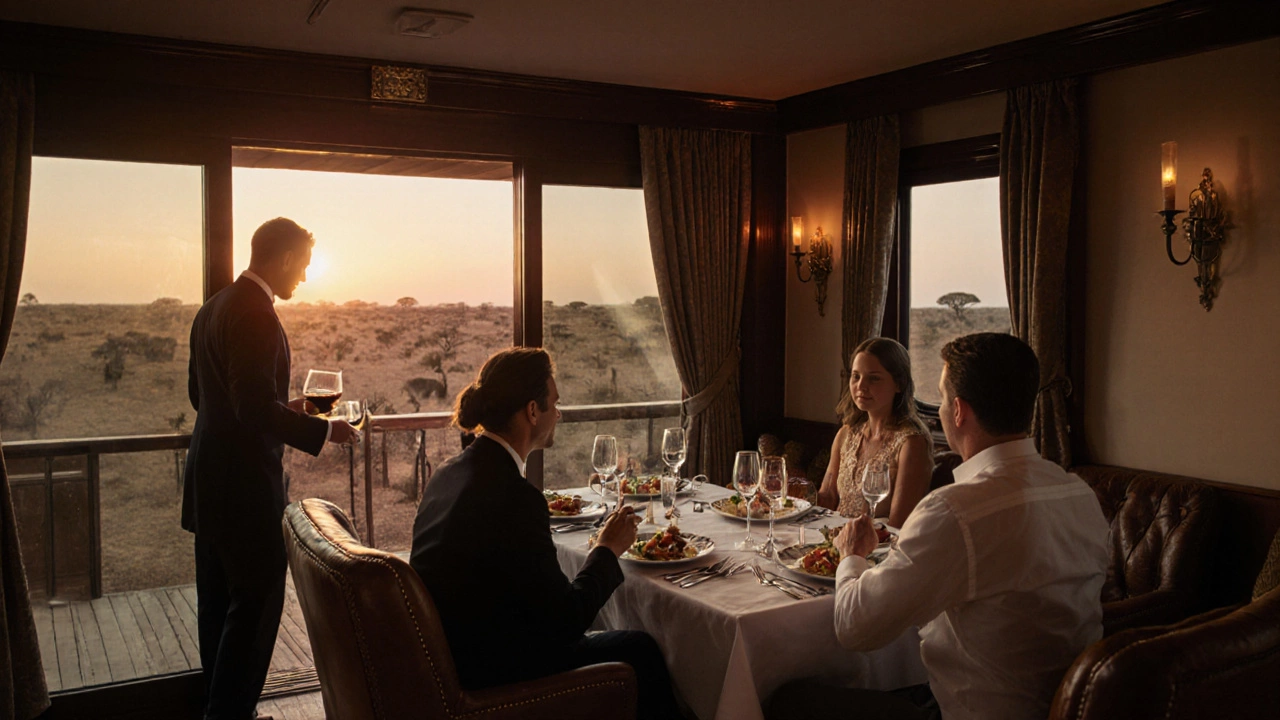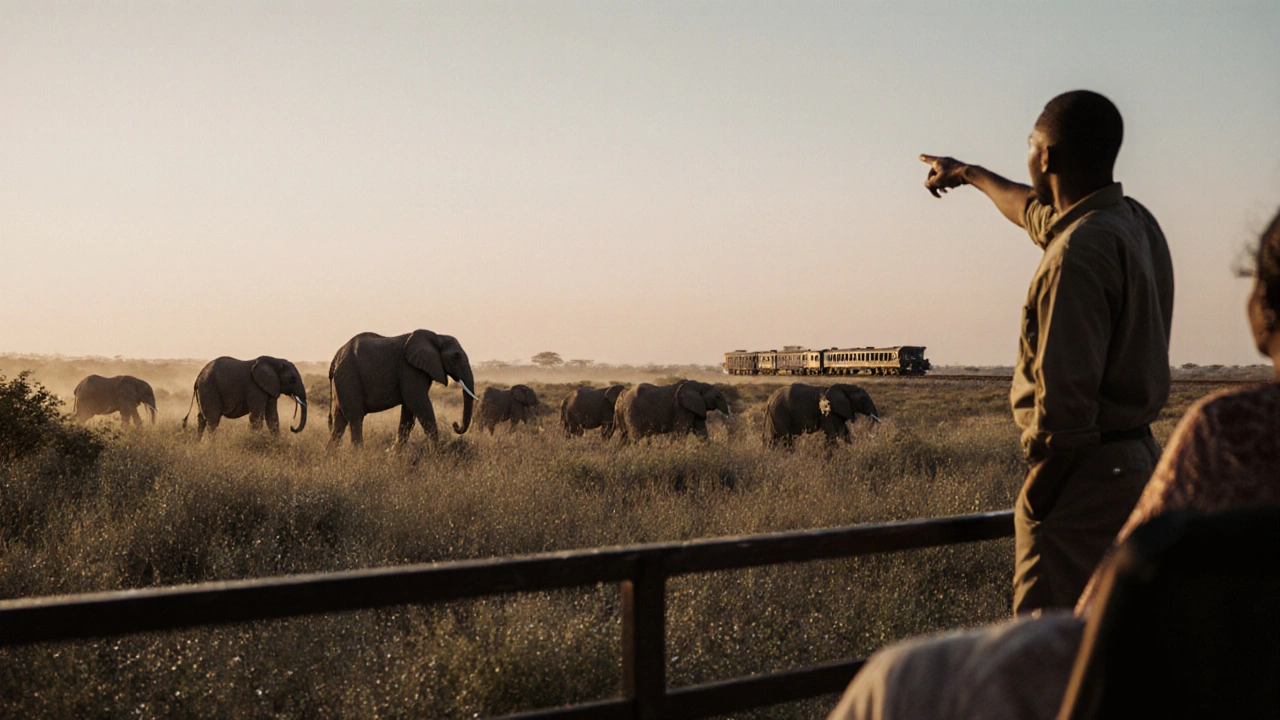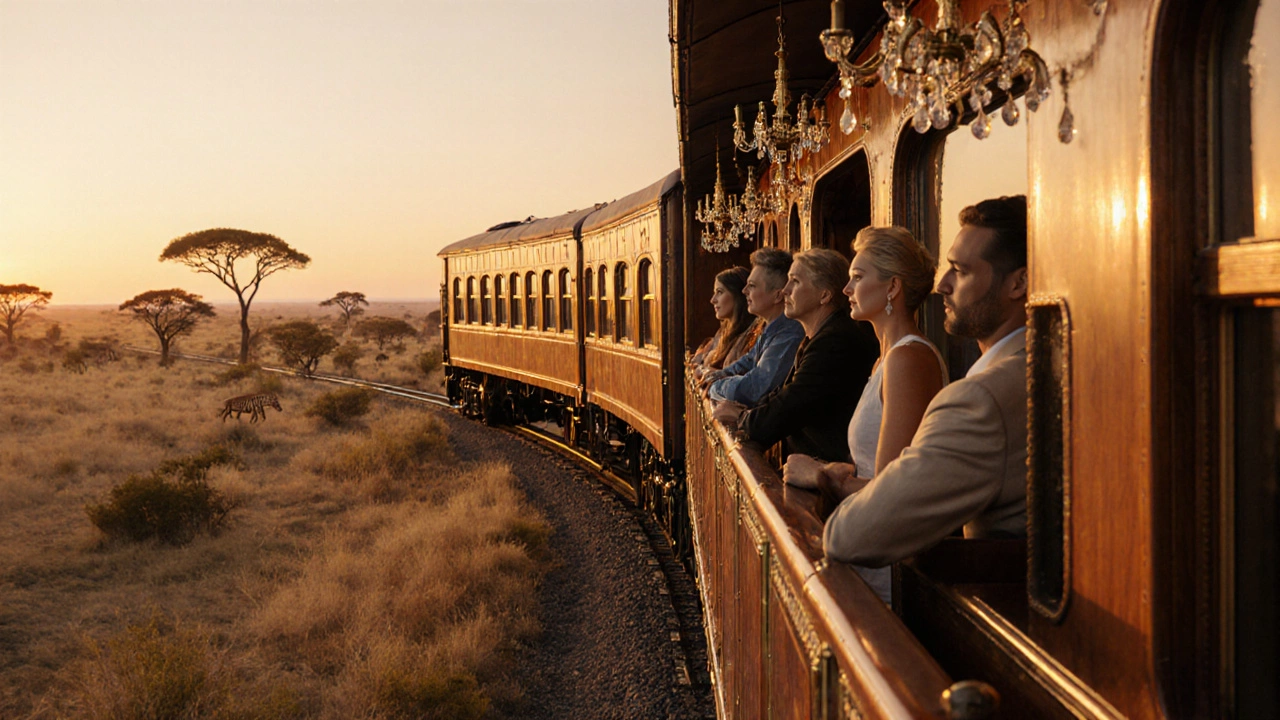Luxury Train Cost Calculator
Choose Your Luxury Train Journey
Calculate costs for your dream rail adventure based on duration and train type
Cost Estimate
Select a train and duration to see your estimate
Value Summary
- Private suites with en-suite bathrooms
- Gourmet meals prepared by professional chefs
- Guided excursions to natural wonders
- Uninterrupted access to scenic landscapes
- Historic, restored rolling stock
There’s a train ride that costs more than a week in a five-star resort, a private island getaway, or even a small car. It doesn’t speed through landscapes-it glides through them, like a moving palace. This isn’t just transportation. It’s a time machine wrapped in velvet, polished brass, and decades of tradition. And yes, it costs over $10,000 just for a single night.
The Price Tag That Stuns Even the Wealthy
The most expensive train ride in the world isn’t found in Europe or North America-it’s the Pride of Africa, operated by Rovos Rail. A 12-day journey from Cape Town to Dar es Salaam, passing through Botswana, Zimbabwe, and Zambia, starts at $12,500 per person. That’s not a typo. For that price, you get a private suite with an en-suite bathroom, gourmet meals prepared by a chef, open-air observation decks, and guided excursions to game reserves and colonial-era towns. There are no hidden fees. No extra charges for wine, tips, or transfers. Everything is included.
Compare that to the Venice Simplon-Orient-Express, often called the most famous luxury train. A three-night trip from London to Venice runs around $7,000-$9,000. The Royal Scotsman in Scotland? About $8,500 for a four-day journey through the Highlands. Both are stunning. But neither touches the scale, distance, or exclusivity of the Pride of Africa.
Why so expensive? Because you’re not just riding a train. You’re stepping into a 1920s-era Pullman carriage restored with African mahogany, hand-stitched leather, and crystal chandeliers. The staff-to-guest ratio is nearly 1:1. Each suite has a butler. The wine list includes vintages from South Africa’s Stellenbosch region, poured by a sommelier who knows your name by day two.
What You Actually Get for That Price
It’s easy to think luxury trains are just about the decor. But the real value is in the experience-and it’s built into every detail.
- Private suites: Each cabin is a room with a view. The Royal Suite on the Pride of Africa measures 22 square meters and includes a double bed, sitting area, and full bathroom with marble fixtures.
- Uninterrupted access: No crowds. No queues. No rushed schedules. You board, settle in, and the world moves outside your window.
- Exclusive excursions: Think private game drives at the Hwange National Park, guided tours of Victoria Falls from a private viewing platform, or a visit to a local village where you meet artisans making traditional baskets.
- Food that rivals Michelin stars: Menus change daily based on regional ingredients. Think ostrich carpaccio, braised lamb with plum sauce, and truffle risotto-all served on fine china with silver cutlery.
- Historic rolling stock: The carriages were built between 1920 and 1947. They were restored over five years using original blueprints. You’re riding on the same steel and wood that carried royalty, diplomats, and explorers nearly a century ago.
There’s no Wi-Fi on board. No TV. No distractions. The point isn’t to check your phone. It’s to watch the sun rise over the Kalahari Desert, listen to the clatter of wheels on old tracks, and sip a glass of Pinotage while the landscape shifts from desert to savanna to misty highlands.
Why This Train Is the Most Expensive
Not every luxury train costs this much. So what makes the Pride of Africa stand out?
First, it’s the distance. At 4,700 kilometers, it’s the longest luxury rail journey on Earth. Most European trains cover 500-800 km. This one spans four countries and five time zones.
Second, it’s the logistics. Moving a 12-carriage train across Africa requires permits, security coordination, rail line access, and custom fueling stations. The train runs only four times a year. Each trip requires over 200 staff members-drivers, chefs, engineers, guides, and housekeeping-working behind the scenes.
Third, it’s the exclusivity. Only 36 guests per trip. That’s fewer people than in a small hotel suite. Bookings are made 12-18 months in advance. There’s no last-minute availability. No discounts. No group rates. If you want to go, you pay the price-and you’re one of the few who ever will.
And unlike other luxury trains that operate on fixed routes, the Pride of Africa changes its itinerary slightly each season. One year, you might visit a diamond mine in Kimberley. The next, you could tour a conservation project for endangered rhinos. The experience evolves, but the standard never drops.

Who Takes This Trip-and Why
The guests aren’t just rich. They’re intentional. They’ve already been to every island, stayed in every overwater bungalow, flown in private jets. Now they want something deeper.
Many are retirees who’ve spent decades building wealth and now seek meaning over material. Others are entrepreneurs who want to disconnect from screens and reconnect with history. A surprising number are couples celebrating 25+ years of marriage. One woman told me she chose this trip because it felt like “a slow, luxurious way to say thank you” to her husband after 30 years of raising kids and running a business.
It’s not a vacation. It’s a ritual. A pilgrimage on rails.
There’s a reason why, after the trip, guests don’t post selfies. They post poems. Letters. Sketches of the landscape. One guest, a retired professor from Oxford, wrote a 12-page memoir about the journey and mailed it to every crew member. That’s the kind of impact this train leaves.
Alternatives That Come Close
If $12,500 feels out of reach, there are other luxury trains that offer a fraction of the experience at a lower price.
| Train | Route | Duration | Price per Person | Key Feature |
|---|---|---|---|---|
| Pride of Africa | Cape Town to Dar es Salaam | 12 days | $12,500+ | Longest route, private excursions, African wildlife |
| Venice Simplon-Orient-Express | London to Venice | 3 nights | $7,000-$9,000 | Art Deco elegance, European charm |
| Royal Scotsman | Scotland Highlands | 4 days | $8,500 | Whisky tastings, castle visits, misty moors |
| Belmond Hiram Bingham | Cusco to Machu Picchu | 1 day | $1,500 | Peruvian culture, gourmet lunch, live Andean music |
| The Blue Train | Pretoria to Cape Town | 2 days | $4,200 | South African luxury, fine dining, spa service |
The Belmond Hiram Bingham and The Blue Train are excellent choices if you want luxury without the multi-week commitment. But neither offers the same level of immersion or the sense of journeying across continents.

Is It Worth It?
Let’s be honest: this isn’t for everyone. If you’re looking for a quick getaway or a Instagrammable moment, this isn’t it. But if you’ve ever dreamed of traveling like the aristocrats of the 1920s-where the journey itself was the destination-then yes. It’s worth every cent.
Think of it this way: you’re not paying for a train ride. You’re paying for 12 days of silence, beauty, and connection. For meals that taste like memory. For a staff who remembers your coffee order after three hours. For a view of the African bush at dawn that you’ll still see in your dreams ten years from now.
And when you get home, you won’t have a pile of souvenirs. You’ll have stories. Stories you’ll tell at dinner parties. Stories that make people lean in. Stories that remind you what it means to truly travel.
How to Book and What to Know Before You Go
If you’re serious about booking the Pride of Africa, here’s what you need to know:
- Book 12-18 months ahead. Trips fill up fast. There’s no waitlist. No cancellations with refunds after 90 days.
- Passport and visas. You need a valid passport with six months’ validity. Visas for Botswana, Zimbabwe, and Zambia are arranged for you-but you must provide passport copies early.
- What to pack. Smart-casual attire for meals. Comfortable walking shoes for excursions. A light jacket for cool evenings. No jeans or sneakers on board. Formal wear is required for dinner on two nights.
- Health precautions. Malaria prophylaxis is recommended for parts of the route. Vaccinations for yellow fever are required for entry into Zambia and Tanzania.
- Payment. A 30% deposit secures your spot. The rest is due 90 days before departure. Credit cards accepted. Wire transfers available.
There’s no app. No online booking portal. You call Rovos Rail directly. Or work with a luxury travel agent who has experience with African rail journeys. They’ll handle the details. You just show up-and let the train take you away.
Is the most expensive train ride worth the cost?
Yes-if you value time, exclusivity, and immersive experiences over material possessions. This isn’t a vacation you’ll forget. It’s a transformation. The cost includes everything: private suites, gourmet meals, guided excursions, wine, and even tips. You’re paying for a rare, slow-motion journey through some of Africa’s most stunning landscapes-with no crowds, no stress, and no distractions.
How long does the most expensive train ride take?
The longest and most expensive train ride is the 12-day journey of the Pride of Africa, covering 4,700 kilometers from Cape Town to Dar es Salaam. Other luxury trains, like the Venice Simplon-Orient-Express, last 3-4 days. But none match the scale, distance, or depth of experience offered by the African route.
Can you take children on the Pride of Africa?
Children under 12 are not permitted on the Pride of Africa. The experience is designed for adults seeking quiet, refined travel. The train’s pace, dining etiquette, and excursions are not suited for young children. Families with older teens may be considered on a case-by-case basis, but it’s rare.
Are there cheaper luxury train options?
Yes. The Blue Train in South Africa offers a 2-day luxury journey for around $4,200. The Belmond Hiram Bingham to Machu Picchu costs about $1,500 for a single day. The Royal Scotsman and Venice Simplon-Orient-Express fall between $7,000 and $9,000. These are still luxury experiences, but they’re shorter and cover less ground.
What’s included in the price of the Pride of Africa?
Everything: private suite with en-suite bathroom, all meals and premium wines, guided excursions, transfers to and from the train, gratuities, and even laundry service. You won’t pay a single extra cent during the trip. The only things not included are souvenirs, spa treatments (optional), and flights to and from the departure city.
What Comes After the Ride?
After the train pulls into Dar es Salaam, the journey doesn’t end. Many guests return home and start planning their next trip-this time, to the Trans-Siberian Railway or the Glacier Express in Switzerland. Others never ride another train. They don’t need to. They’ve already lived the dream.
The most expensive train ride isn’t about luxury for luxury’s sake. It’s about reclaiming time. Slowing down. Remembering what it feels like to be truly present.
And if you’ve ever wondered how much a perfect day costs? It’s not $100. It’s not $1,000. It’s $12,500-and a lifetime of memories.
